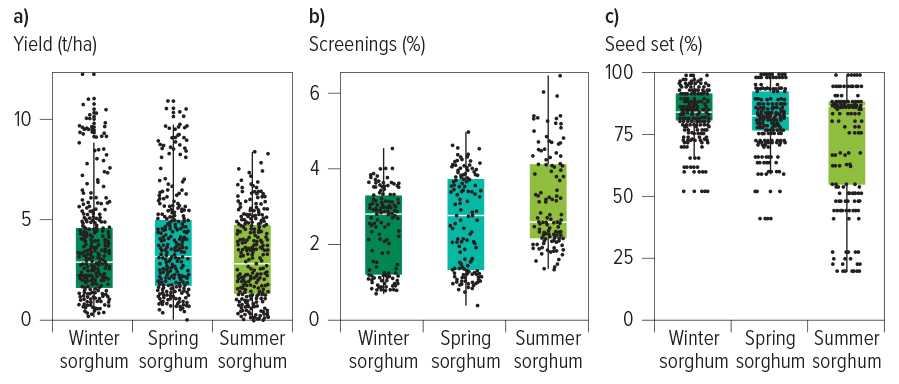Limited water and extreme heat at flowering are common constraints on sorghum production. However, in recent seasons lack of spring sowing opportunities has reduced sown areas and grain yields, and eliminated double cropping opportunities, as most sorghum crops have been sown too late in summer.
Traditionally, sorghum is a summer crop, sown when morning (9am) soil temperatures at sowing depth are 16°C or higher and the risk of frost has passed. However, with GRDC investment, these ideas are being challenged by researchers proposing sorghum could be sown in late winter, into soil moisture, as long as soil temperatures at sowing depth are 12°C and rising.
The strategy might seem simple, but its implications and implementation are not.
Risks and opportunities
A sorghum crop sown in winter will risk having a long emergence period. This will increase likelihood of some seeds running out of soil moisture, and soil insect damage resulting in non-uniform stands with implications for weed competition and yield. This can be overcome by sowing with high-quality seed into moist soils when soil temperatures are at least 12°C.
However, there are many advantages:
- sowing sorghum in winter and early spring increases opportunities for sowing in regions where spring rainfall is highly variable and shifting towards late summer months;
- high solar radiation and lower temperatures in winter and early spring provide environments more conducive to higher yield potentials and water use efficiencies
- crops sown in winter will flower earlier and avoid heat stresses and dry finishes, increasing seed set and reducing screenings; and
- winter and early spring sown sorghum will significantly increase chances of double cropping a winter crop after a short summer fallow, or allow for the crop to be ratooned into a second harvest, if irrigation is available.
So, the advantages appear to outweigh the risks and provide a new opportunity for sorghum growers to increase cropping intensity and profitability.
Initial results
Results from two years of on-farm collaborative experimentation with the Queensland Department of Agriculture and Fisheries and NSW Department of Primary Industries led by the Queensland Alliance for Agriculture and Food Innovation have been analysed using a new method developed in collaboration with SAGI.
The results show important interactions between hybrid and management across the tested environments. Figures 1a and b show sorghum can be sown into cooler soils at no yield loss and with reduced screenings. Benefits of early sowing also include the avoidance of heat stresses at flowering with benefits on seed set (Figure 1c).
Figure 1: Boxplot and observations (dots) of (a) averaged yields, (b) percent screenings and (c) effect of high temperatures around flowering on seed set (%) of six commercial sorghum hybrids sown at four plant densities in winter, spring and summer across 15 site seasons in eastern Australia.

Source: QAAFI, The University of Queensland
Growing sorghum earlier in the year will significantly increases chances of double cropping into a winter crop, or in irrigated systems, ratooning the sorghum into a second harvest to produce gross margins higher than those of cotton.
Additional considerations
Seed quality and control of soil insects are vital for uniform establishment in cold soils.
Seed quality should be tested, especially vigour at low temperatures. Sorghum appears to tolerate frosts of -2°C and -3°C before the crop has six to seven leaves, though if sowing with about 12°C at sowing depth, a 20 to 40 per cent increase in plant populations is recommended. This necessary increase in seeding rate is a minor cost given the possibility of growing a second crop in the same year.
Further research
Further research will quantify crop and root growth and function in cold soils and consider implications on crop water use and cropping systems’ water use efficiency.
Initial results suggest that winter-sown crops will transfer water use from vegetative stages to the crop’s reproductive stages, significantly reducing the chances of dry finishes, high screenings and crop lodging. Impacts on cropping system economics are being modelled for winter, spring and summer sorghum cropping systems using the Agricultural Production Systems sIMulator (APSIM).
More information: Daniel Rodriguez, 0434 075 094, d.rodriguez@uq.edu.au; Joe Eyre 0467 737 237, j.eyre@uq.edu.au

























































